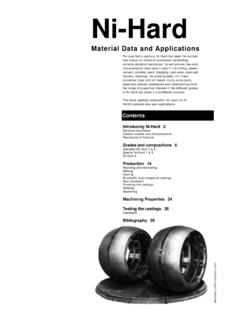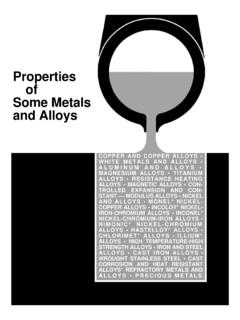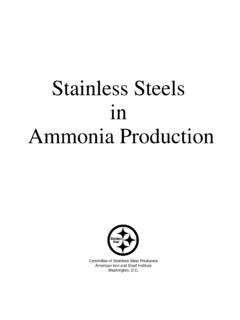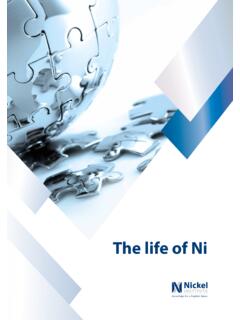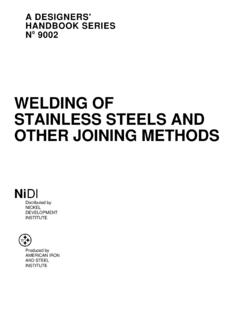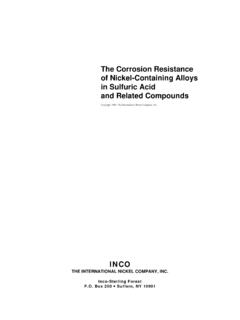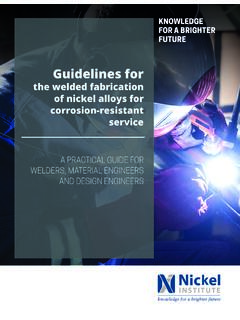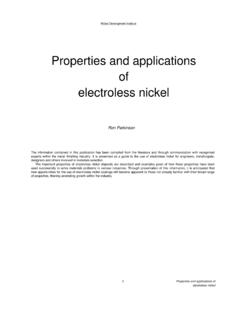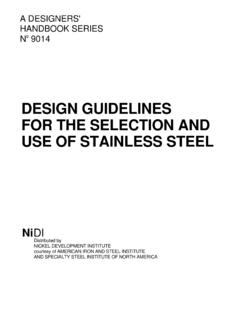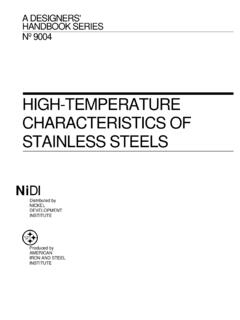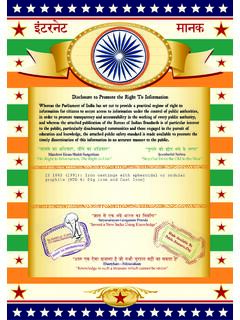Transcription of Properties and Applications of Ni-Resist and Ductile Ni ...
1 Properties and Applications of Ni-Resist and Ductile Ni-Resist Alloys Table of Contents Introduction .. 1 The Alloys .. 2 National and International 21 Corrosion Data .. 27 1 Properties and Applications of Ni-Resist and Ductile Ni-Resist Alloys General Characteristics of the Ni-Resist Austenitic Cast iron Alloys There are two families of Ni-Resist austenitic cast irons. These are the standard or flake graphite alloys and the Ductile or spheroidal graphite alloys. As time passes, the spheroidal grades, because of higher strength, ductility and elevated temperature Properties , are becoming more prominent. However, the flake materials with lower cost, fewer foundry problems and better machinability and thermal conductivity are still produced by many foun-dries.
2 General characteristics of both groups are de-scribed below. Corrosion Resistance: The Ni-Resists are specified for handling salt solutions, sea water, mild acids, alkalies and oil field liquids, both sweet and sour. Their corrosion resistance is far superior to that of normal and low alloy cast irons. They are not stainless steels and do not behave as such. They are characterized by uniform corrosion rather than by localized deterioration. Wear Resistance: Cylinder liners, pistons, wear rings and sleeves, bearings, glands and other metal-to-metal rubbing parts are cast in Ni-Resist alloys. Their galling resistance is excellent. Erosion Resistance: Slurries, wet steam and other fluids with entrained solids are substances which are extremely erosive to most metals.
3 Ni-Resist alloys offer a combination of corrosion-erosion resistance which is superior in these environments. They are outstanding when compared to gray cast iron , Ductile irons and steel. Toughness and Low Temperature Stability: Ni-Resist alloys are much superior to gray cast iron , particularly at low temperatures. Controlled Expansion: Expansivities from as low as X 10-6 to as high as X 10-6 cm/cm per C ( X 10-6 to X 10-6 in/in per F) are possible with the different Ni-Resist alloys. The lower value makes possible a cast metal with low expansivity for precision parts. Also, the range permits matching Ni-Resists with many different metals and alloys.
4 Magnetic and Electrical Properties : Some Ni-Resist alloys are non-magnetic. These and others have high electrical resistance. Thus, they are used for resistance grids, electric furnace parts, in clutches and other appli-cations requiring these Properties combined with machinability and heat resistance. Heat Resistance: Originally, because of good heat and oxidation resistance, the flake graphite Ni-Resist alloys were used at temperatures up to 700 C(1300 F). How-ever, because of the superior elevated temperature Properties of the spheroidal graphite Ni-Resists, the flake alloys are now seldom used above 315 C(600 F). spheroidal graphite Ni-Resist alloys can be and are used at temperatures up to 1050 C(1930 F).
5 Although the Ductile alloys are better, all Ni-Resists have relatively low rates of oxidation in air. The resulting oxides adhere tenaciously, further reducing oxidation with time. Machinability: The machining techniques possible for Ni-Resist castings are similar to those for the higher strength grades of gray cast iron and austenitic stainless steels. Castability: Complicated and intricate designs that are often difficult to cast in other materials are possible with Ni-Resist alloys. This leads to products that are eco-nomically produced. 2 Part I The Alloys The Ni-Resist cast irons are a family of alloys with sufficient nickel to produce an austenitic structure which has unique and superior Properties .
6 The family is divided into two groups. These are the standard or flake graphite alloys and the Ductile or spheroidal graphite alloys. Except for the copper containing ones, the groups have materials similar in composition but for a magnesium addition which converts the graphite to the spheroidal form in the Ductile Ni-Resists. Copper interferes with the magnesium treatment and alloys high in copper cannot be produced with spheroidal graphite . Typical micro-structures of flake and spheroidal graphite alloys are shown in Figures 1 and 2, respectively. Table IITypical Nomenclatures for spheroidal graphite Ni-Resist Alloys Common Name ASTM A439-83 A571-84 ISO 2892-1973 DIN 1694 BS 3468.
7 1986 NiResist D-2 Type D-2 SAO 20 2 GGG-NiCr 20 2 Grade S2 NiResist D-2W - - GGG-NiCrNb 20 2 Grade S2 WNiResist D-2B Type D-2B SAO 20 3 GGG-NiCr 20 3 Grade S2 BNicrosilal Spheronic- SASCr 20 5 2 GGG-NiSiCr 20 5 2 - NiResist D-2C Type D-2C S-Ni 22 GGG-Ni 22 Grade S2 CNiResist D-2M Type D-2M SAW 23 4 GGG-NiMn 23 4 Grade S2 MNiResist D-3A Type D-3A S-NO 301 GGG-NiCr 301 - NiResist D-3 Type D-3 SAO 30 3 GGG-NiCr 30 3 Grade S3 NiResist D-4A - - GGG-NiCr 30 5 2 - NiResist D-4 Type D-4 S-NiSiCr 30 5 5 GGG-NiSiCr 30 5 5 - NiResist D-5 Type D-5 S-Ni 35 GGG-Ni 35 - NiResist D-5B Type D-5B SAO 35 3 GGG-NiCr 35 3 - NiResist D-5S Type D-5S S-NiSiCr 35 5 2 GGG-NiSiCr 35 5 2 Grade S5 SNiResist D-6 - SAW 13 7 GGG-NiMn 13 7 Grade S6 FLAKE graphite ALLOYS Figure 2 Typical Microstructure of spheroidal graphite Ni-Resist Alloys - Ni-Resist D-2W - graphite Spheres and Carbide Areas within Austenite Matrix Ni-Resist NiMn 13 7 Relatively low cost, non-magnetic alloy is not used where corrosion and/or high temperature resistance are required.
8 Ni-Resist 1 Good resistance to corrosion in alkalis, dilute acids, sea water and other salt solutions has good moderate temperature and wear resistance. Used for pumps, valves and products where wear resistance is required. Used for piston ring inserts because of match-ing expansion characteristics of aluminum piston alloys. Ni-Resist 1b Similar Applications as Ni-Resist 1, but Figure 1 Typical Microstructure of Flake graphite Ni-Resist Alloys - Ni-Resist 1- graphite Flakes and Carbide Areas within Austenite Matrix Testing and Materials(ASTM), the International Stand-ards Institute (ISO), The Deutsches Institut fur Normung (DIN) and the British Standards Institute (BSI).
9 Some other national designations are given in Part II. Nominal chemical compositions are in Tables III and IV. Refer to the national or international specifications for precise chemical requirements. Table ITypical Nomenclatures for Flake graphite Ni-Resist Alloys Common Name ASTM A 436-84 ISO 2892-1973 DIN 1694 BS 3468:1986 NiMn 13 7 - L-NiMn 13 7 GGL-NiMn 13 7 - NiResist 1 Type 1 L-NiCuCr 15 6 2 GGL-NiCuCr 15 6 2 Grade F1Ni-Resist 1b Type 1 b L-NiCuCr 15 6 3 GGL-NiCuCr 15 6 3- Ni-Resist 2 Type 2 L-NiCr 20 2 GGL-NiCr 20 2 Grade F2Ni-Resist 2b Type 2b L-NiCr 20 3 GGL-NiCr 20 3 - Nicrosilal - L-NiSiCr 20 5 3 GGL-NiSiCr 20 5 3 - Ni-Resist 3 Type 3 L-NiCr 30 3 GGL-NiCr 30 3 Grade F3Ni-Resist 4 Type 4 L-NiSiCr 30 5 5 GGL-NiSiOr 30 5 5- Ni-Resist 5 Type 5 L-Ni 35 - - Ni-Resist 6 Type 6 - - - The composition and Properties of the Ni-Resists are covered by a number of national and international speci-fications.
10 Unfortunately, the nomenclature describing these alloys varies from country to country. Tables I and II give the common name for the various alloys and their designations in four different specifications. The speci-fying bodies in these tables are the American Society for Ni-Resist Alloys 3 Nicrosilal Has improved corrosion resistance in dilute sulfuric acid. Used for pumps, valves and other castings requiring higher mechanical Properties . Ni-Resist 3 Has resistant to corrosion in wet steam and corrosive slurries. Can be used where it is necessary to match the coefficient of expansion of gray cast iron or steel at temperatures around 260 C(500 F). Applications include pumps, valves and machinery castings.
